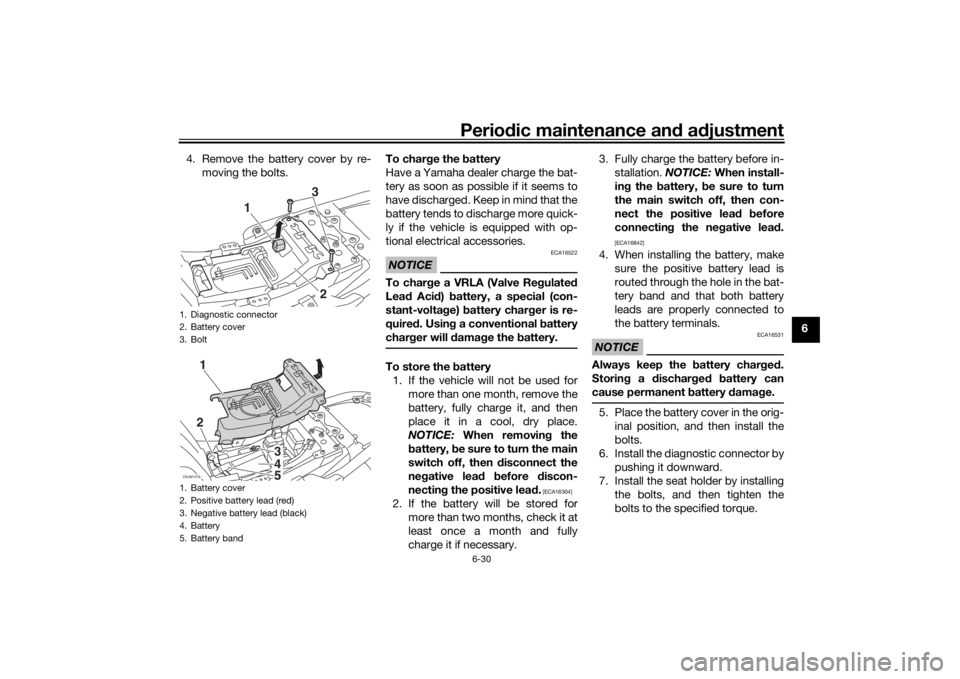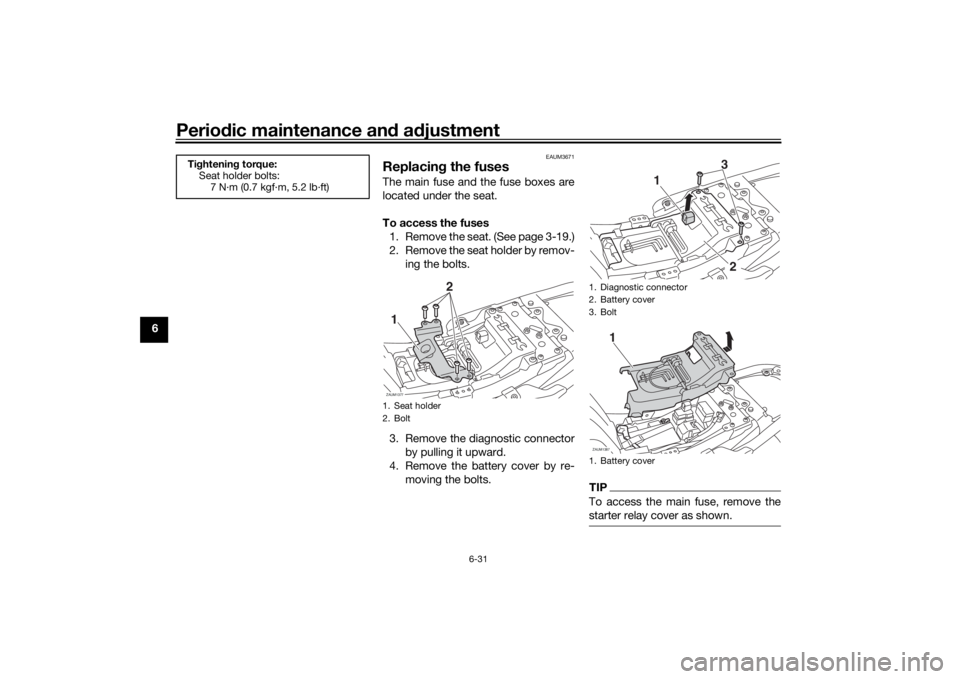2018 YAMAHA XSR 700 seat adjustment
[x] Cancel search: seat adjustmentPage 6 of 98

Table of contentsSafety information............................ 1-1
Description....................................... 2-1
Left view ......................................... 2-1
Right view ....................................... 2-2
Controls and instruments ............... 2-3
Instrument and control functions... 3-1
Immobilizer system......................... 3-1
Main switch/steering lock............... 3-2
Indicator lights and warning
lights............................................ 3-3
Multi-function meter unit ................ 3-6
Handlebar switches ...................... 3-12
Clutch lever .................................. 3-13
Shift pedal .................................... 3-13
Brake lever.................................... 3-14
Brake pedal .................................. 3-14
ABS .............................................. 3-14
Fuel tank cap ................................ 3-15
Fuel ............................................... 3-16
Fuel tank breather hose and
overflow hose ............................ 3-18
Catalytic converter ....................... 3-18
Seat .............................................. 3-19
Helmet holding cable.................... 3-19
Adjusting the shock absorber
assembly ................................... 3-21
Auxiliary DC connector ................. 3-22
Sidestand ..................................... 3-22
Ignition circuit cut-off system ....... 3-23For your safety – pre-operation
checks............................................... 4-1
Operation and important riding
points................................................. 5-1
Starting the engine .......................... 5-1
Shifting ............................................ 5-2
Tips for reducing fuel
consumption ................................ 5-4
Engine break-in ............................... 5-4
Parking ............................................ 5-5
Periodic maintenance and
adjustment........................................ 6-1
Owner’s tool kit ............................... 6-2
Periodic maintenance charts .......... 6-3
Periodic maintenance chart for the
emission control system .............. 6-3
General maintenance and
lubrication chart ........................... 6-5
Checking the spark plugs ............... 6-9
Canister ......................................... 6-10
Engine oil and oil filter cartridge.... 6-10
Coolant.......................................... 6-13
Replacing the air filter element and
cleaning the check hose ............ 6-14
Checking the throttle grip free
play ............................................ 6-15
Valve clearance ............................. 6-15
Tires .............................................. 6-16
Cast wheels................................... 6-18Adjusting the clutch lever free
play ............................................ 6-18
Checking the brake lever free
play ............................................ 6-19
Brake light switches ..................... 6-20
Checking the front and rear brake
pads .......................................... 6-20
Checking the brake fluid level ...... 6-21
Changing the brake fluid .............. 6-22
Drive chain slack........................... 6-22
Cleaning and lubricating the drive
chain.......................................... 6-24
Checking and lubricating the
cables ........................................ 6-25
Checking and lubricating the
throttle grip and cable ............... 6-25
Checking and lubricating the
brake and shift pedals............... 6-25
Checking and lubricating the
brake and clutch levers ............. 6-26
Checking and lubricating the
sidestand................................... 6-27
Lubricating the rear suspension ... 6-27
Lubricating the swingarm
pivots......................................... 6-27
Checking the front fork ................. 6-28
Checking the steering................... 6-28
Checking the wheel bearings ....... 6-29
Battery .......................................... 6-29
Replacing the fuses ...................... 6-31
Replacing the headlight bulb ........ 6-33UBU3E1E0.book Page 1 Monday, June 4, 2018 5:20 PM
Page 49 of 98

Periodic maintenance and adjustment
6-2
6
EAU17383
Owner’s tool kitThe owner’s tool kit is located under
the seat. (See page 3-19.)
The service information included in this
manual and the tools provided in the
owner’s tool kit are intended to assist
you in the performance of preventive
maintenance and minor repairs. How-
ever, additional tools such as a torque
wrench may be necessary to perform
certain maintenance work correctly.TIPIf you do not have the tools or experi-
ence required for a particular job, have
a Yamaha dealer perform it for you.1.
1
UBU3E1E0.book Page 2 Monday, June 4, 2018 5:20 PM
Page 58 of 98

Periodic maintenance and adjustment
6-11
6To change the engine oil (with or
without oil filter cartridge replace-
ment)
1. Place the vehicle on a level sur-
face.
2. Start the engine, warm it up for
several minutes, and then turn it
off.
3. Place an oil pan under the engine
to collect the used oil.
4. Remove the engine oil filler cap,
the engine oil drain bolt and its
gasket to drain the oil from the
crankcase.
TIPSkip steps 5…7 if the oil filter cartridge
is not being replaced.5. Remove the oil filter cartridge with
an oil filter wrench.
TIPAn oil filter wrench is available at a
Yamaha dealer.6. Apply a thin coat of clean engine
oil to the O-ring of the new oil filter
cartridge.TIPMake sure that the O-ring is properly
seated.7. Install the new oil filter cartridge
with an oil filter wrench, and then
tighten it to the specified torque
with a torque wrench.
1. Engine oil filler cap
2. O-ring
21
1. Engine oil drain bolt
2. Gasket
1. Oil filter wrench
2. Oil filter cartridge
2
1
2
1
1. O-ring
UBU3E1E0.book Page 11 Monday, June 4, 2018 5:20 PM
Page 76 of 98

Periodic maintenance and adjustment
6-29
6
EAU23292
Checking the wheel bearingsThe front and rear wheel bearings must
be checked at the intervals specified in
the periodic maintenance and lubrica-
tion chart. If there is play in the wheel
hub or if the wheel does not turn
smoothly, have a Yamaha dealer
check the wheel bearings.
EAUM3751
BatteryThis model is equipped with a VRLA
(Valve Regulated Lead Acid) battery.
There is no need to check the electro-
lyte or to add distilled water. However,
the battery lead connections need to
be checked and, if necessary, tight-
ened.
WARNING
EWA10761
Electrolyte is poisonous and
dangerous since it contains sul-
furic acid, which causes severe
burns. Avoid any contact with
skin, eyes or clothing and al-
ways shield your eyes when
working near batteries. In case
of contact, administer the fol-
lowing FIRST AID.
EXTERNAL: Flush with plenty
of water.
INTERNAL: Drink large quan-
tities of water or milk and im-
mediately call a physician.
EYES: Flush with water for 15
minutes and seek prompt
medical attention.Batteries produce explosive hy-
drogen gas. Therefore, keep
sparks, flames, cigarettes, etc.,
away from the battery and pro-
vide sufficient ventilation when
charging it in an enclosed
space.
KEEP THIS AND ALL BATTER-
IES OUT OF THE REACH OF
CHILDREN.
To access the battery
1. Remove the seat. (See page 3-19.)
2. Remove the seat holder by remov-
ing the bolts.
3. Remove the diagnostic connector
by pulling it upward.1. Seat holder
2. BoltZAUM1377
2
1
UBU3E1E0.book Page 29 Monday, June 4, 2018 5:20 PM
Page 77 of 98

Periodic maintenance and adjustment
6-30
6 4. Remove the battery cover by re-
moving the bolts.To charge the battery
Have a Yamaha dealer charge the bat-
tery as soon as possible if it seems to
h a ve d is c h ar g e d . K e e p i n m i nd th a t th e
battery tends to discharge more quick-
ly if the vehicle is equipped with op-
tional electrical accessories.
NOTICE
ECA16522
To charge a VRLA (Valve Regulated
Lead Acid) battery, a special (con-
stant-voltage) battery charger is re-
quired. Using a conventional battery
charger will damage the battery.To store the battery
1. If the vehicle will not be used for
more than one month, remove the
battery, fully charge it, and then
place it in a cool, dry place.
NOTICE: When removing the
battery, be sure to turn the main
switch off, then disconnect the
negative lead before discon-
necting the positive lead.
[ECA16304]
2. If the battery will be stored for
more than two months, check it at
least once a month and fully
charge it if necessary.3. Fully charge the battery before in-
stallation. NOTICE: When install-
ing the battery, be sure to turn
the main switch off, then con-
nect the positive lead before
connecting the negative lead.
[ECA16842]
4. When installing the battery, make
sure the positive battery lead is
routed through the hole in the bat-
tery band and that both battery
leads are properly connected to
the battery terminals.NOTICE
ECA16531
Always keep the battery charged.
Storing a discharged battery can
cause permanent battery damage.5. Place the battery cover in the orig-
inal position, and then install the
bolts.
6. Install the diagnostic connector by
pushing it downward.
7. Install the seat holder by installing
the bolts, and then tighten the
bolts to the specified torque.
1. Diagnostic connector
2. Battery cover
3. Bolt
1. Battery cover
2. Positive battery lead (red)
3. Negative battery lead (black)
4. Battery
5. Battery band
3
12
ZAUM1379
12
34
UBU3E1E0.book Page 30 Monday, June 4, 2018 5:20 PM
Page 78 of 98

Periodic maintenance and adjustment
6-31
6
EAUM3671
Replacing the fusesThe main fuse and the fuse boxes are
located under the seat.
To access the fuses
1. Remove the seat. (See page 3-19.)
2. Remove the seat holder by remov-
ing the bolts.
3. Remove the diagnostic connector
by pulling it upward.
4. Remove the battery cover by re-
moving the bolts.
TIPTo access the main fuse, remove the
starter relay cover as shown.
Tightening torque:
Seat holder bolts:
7 N·m (0.7 kgf·m, 5.2 lb·ft)
1. Seat holder
2. BoltZAUM1377
2
1
1. Diagnostic connector
2. Battery cover
3. Bolt
1. Battery cover
3
12
ZAUM1387
1
UBU3E1E0.book Page 31 Monday, June 4, 2018 5:20 PM
Page 80 of 98

Periodic maintenance and adjustment
6-33
63. Turn the key to “ON” and turn on
the electrical circuit in question to
check if the device operates.
4. If the fuse immediately blows
again, have a Yamaha dealer
check the electrical system.
5. After the fuse is changed, place
the battery cover in the original
position, and then install the bolts.
6. Install the diagnostic connector by
pushing it downward.
7. Install the seat holder by installing
the bolts, and then tighten the
bolts to the specified torque.
EAU34386
Replacing the headlight bulbThis model is equipped with a halogen
bulb headlight. If the headlight bulb
burns out, replace it as follows.NOTICE
ECA10651
Take care not to damage the follow-
ing parts:
Headlight bulb
Do not touch the glass part of
the headlight bulb to keep it free
from oil, otherwise the transpar-
ency of the glass, the luminosity
of the bulb, and the bulb life will
be adversely affected. Thor-
oughly clean off any dirt and fin-
gerprints on the headlight bulb
using a cloth moistened with al-
cohol or thinner.
Headlight lens
Do not affix any type of tinted
film or stickers to the headlight
lens.
Do not use a headlight bulb of a
wattage higher than specified.
1. Remove the headlight unit by re-
moving the bolts on each side.
2. Disconnect the headlight coupler,
and then remove the headlight
bulb cover.
Tightening torque:
Seat holder bolts:
7 N·m (0.7 kgf·m, 5.2 lb·ft)
1. Do not touch the glass part of the bulb.
1. BoltZAUM13811
UBU3E1E0.book Page 33 Monday, June 4, 2018 5:20 PM